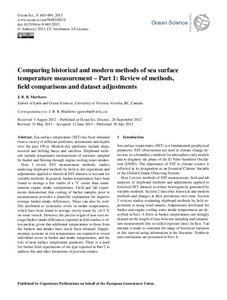| dc.contributor.author | Matthews, J. B. R. | |
| dc.date.accessioned | 2019-03-08T15:44:22Z | |
| dc.date.available | 2019-03-08T15:44:22Z | |
| dc.date.issued | 2013 | |
| dc.identifier.citation | Matthews, J. B. R. (2013) Comparing historical and modern methods of sea surface
temperature measurement – Part 1: Review of methods, field comparisons and dataset adjustments. Ocean Science, 9, pp.683–694. DOI: :10.5194/os-9-683-2013 | en_US |
| dc.identifier.uri | http://hdl.handle.net/11329/875 | |
| dc.identifier.uri | http://dx.doi.org/10.25607/OBP-422 | |
| dc.description.abstract | Sea surface temperature (SST) has been obtained
from a variety of different platforms, instruments and depths
over the past 150 yr. Modern-day platforms include ships,
moored and drifting buoys and satellites. Shipboard methods include temperature measurement of seawater sampled
by bucket and flowing through engine cooling water intakes.
Here I review SST measurement methods, studies
analysing shipboard methods by field or lab experiment and
adjustments applied to historical SST datasets to account for
variable methods. In general, bucket temperatures have been
found to average a few tenths of a ◦C cooler than simultaneous engine intake temperatures. Field and lab experiments demonstrate that cooling of bucket samples prior to
measurement provides a plausible explanation for negative
average bucket-intake differences. These can also be credibly attributed to systematic errors in intake temperatures,
which have been found to average overly-warm by >0.5 ◦C
on some vessels. However, the precise origin of non-zero average bucket-intake differences reported in field studies is often unclear, given that additional temperatures to those from
the buckets and intakes have rarely been obtained. Supplementary accurate in situ temperatures are required to reveal
individual errors in bucket and intake temperatures, and the
role of near-surface temperature gradients. There is a need
for further field experiments of the type reported in Part 2 to
address this and other limitations of previous studies. | en_US |
| dc.language.iso | en | en_US |
| dc.rights | Attribution 3.0 | * |
| dc.rights.uri | http://creativecommons.org/licenses/by/3.0 | * |
| dc.subject.other | Bucket temperature | en_US |
| dc.title | Comparing historical and modern methods of sea surface temperature measurement – Part 1: Review of methods, field comparisons and dataset adjustments. | en_US |
| dc.type | Journal Contribution | en_US |
| dc.description.refereed | Refereed | en_US |
| dc.format.pagerange | pp.683–694 | en_US |
| dc.identifier.doi | 10.5194/os-9-683-2013 | |
| dc.subject.parameterDiscipline | Parameter Discipline::Physical oceanography | en_US |
| dc.bibliographicCitation.title | Ocean Science | en_US |
| dc.bibliographicCitation.volume | 9 | en_US |
| dc.description.eov | Sea surface temperature | en_US |
| dc.description.bptype | Guide | en_US |
| obps.contact.contactemail | georobin@uvic.ca | |
| obps.resourceurl.publisher | https://www.ocean-sci.net/9/683/2013/os-9-683-2013.pdf | en_US |
 Repository of community practices in Ocean Research, Applications and Data/Information Management
Repository of community practices in Ocean Research, Applications and Data/Information Management

